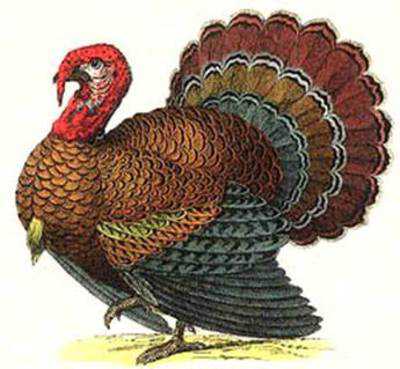Names for a much-travelled bird
About 1530, a new dish began to be put on English tables, a fowl a little larger than the traditional goose, but with a lot more meat and a refreshingly new taste. This bird had been brought to England by merchants trading out of that area of the eastern Mediterranean called the Levant but whom the English called “Turkey merchants” because that whole area was then part of the Turkish empire. The new bird was therefore called a “Turkey bird”, or “Turkey cock”. Within a few years it had become a favourite and familiar domestic fowl, to the extent that, sixty years later, Shakespeare knew his groundlings would understand the reference to the turkey’s aggression display of blowing out its breast and strutting when he described the posturings of Malvolio in Twelfth Night:
SIR TOBY BELCH: Here’s an overwheening rogue!
FABIAN: O, peace! Contemplation makes a rare turkey-cock of him; how he jets under his advanced plumes!
The interesting thing about the mistake over the turkey’s origins is that the English were the only people to believe they came from Turkey; nearly everyone else, including the Turks, thought they originated in India, or at least in the place they then thought was India. Turkeys actually came from Mexico and were first brought back from there about 1520, at a time when that area was called The Spanish Indies or the New Indies, illustrating the confusion in people’s minds about the true location of this new land that Columbus had found. As a result, a lot of European languages, as well as others like Arabic and Hebrew, called it something like the “bird of India” (for example, indianischer Hahn in old German).
But in a few languages, including Danish, Dutch, Finnish and Norwegian, the bird was named instead as coming from Calicut (Dutch kalkoense hahn, Danish kalkun), which is a seaport on the Malabar coast of India, the same place after which calico is named. As the turkey didn’t reach India for about a hundred years after its European introduction and naming, this looks mysteriously specific. But there may be an explanation. The turkey was introduced into Europe only about twenty years after the Portuguese explorer Vasco da Gama had pioneered the route round the Cape of Good Hope, up the east coast of Africa and across to India, where he landed in 1498 — at Calicut. It could be that people made the connection “bird of India” = “bird of Calicut” because they had heard about the Portuguese explorations and mistakenly thought the bird had been brought back from there, instead of the New Indies.
To compound the difficulties the English had with this immigrant, at about the same time, the 1530s, Portuguese merchants reintroduced the guinea-fowl from West Africa, which had last been seen in England at the time of the Romans. As it was the same Levant merchants who brought this into the country, the guinea fowl was also known for a time as the Turkey bird, though this confusion didn’t last long. For example, the heraldic arms granted to William Strickland in 1550 featured “a turkey-bird in his pride proper” and the bird shown is quite definitely a proper turkey. The only surviving instance of this confusion between the turkey and the guinea-fowl — but it’s a big one — was caused by Linnaeus; when he invented the new generic name for the turkey and its relatives he called it meleagris, which had been the name in classical Rome for … the guinea-fowl.
As an aside to this, and to illustrate the total confusion over its origins by everyone, when the turkey did arrive in India, it was brought there via the Spanish possessions in the East Indies, and one name for it was the “Peru bird”, most probably because that was what the Portuguese, with their strong colonial presence in India, called it; still quite wrong, because there were no turkeys in Peru, but at least they had the right area of the world.
And the domestic turkey was re-introduced into North America from Britain, taken there circuitously by the colonists of New England and Virginia, who were surprised to find it living there wild. Benjamin Franklin once suggested its wild cousin should become the national bird of the United States. If of any country, it should be Mexico of course, but because of its wide travels and the total confusion over its origins, perhaps instead the turkey ought to be the official bird of the world.
via World Wide Words: Talking Turkey.
http://www.worldwidewords.org/articles/turkey.htm


Leave a Reply